 |
November 15, 2008
| Sextant Boxes |
 one of the airplane parts and scraps of aluminum we’ve found in Nikumaroro’s abandoned village is marked with a serial number, but then, very few components of Earhart’s
Electra had serial numbers. There was, however, an artifact found on Nikumaroro
that carried not one, but two apparent serial numbers that may be linked
to the mystery. It was not an airplane part and it was not found by TIGHAR.
(You did write down and put aside two numbers of your own choosing … right?)
one of the airplane parts and scraps of aluminum we’ve found in Nikumaroro’s abandoned village is marked with a serial number, but then, very few components of Earhart’s
Electra had serial numbers. There was, however, an artifact found on Nikumaroro
that carried not one, but two apparent serial numbers that may be linked
to the mystery. It was not an airplane part and it was not found by TIGHAR.
(You did write down and put aside two numbers of your own choosing … right?)
In a radio message to his superiors dated September 23, 1940, British Colonial Service officer Gerald Gallagher wrote:
Some months ago [a] working party on Gardner discovered [a] human skull – this was buried and I only recently heard about it. Thorough search has now produced more bones (including lower jaw) part of a shoe, a bottle, and a sextant box. … Sextant box has two numbers on it 3500 (stenciled) and 1542 – sextant being old fashioned and probably painted over with black enamel.…
(You can see where this is going. If you haven’t written down your two numbers by now, don’t bother. It’s too late. You already have too much information.)
What made Gallagher think that the sextant had been painted with black enamel is not known, but it seems probable that there were flecks of black enamel paint present in the box. British authorities in Fiji saw the numbers on the sextant box as potential clues to the castaway’s identity but no one, including Harold Gatty, could make sense of them. The famous Australian aerial navigator was in Fiji at the time. He was shown the box and his opinion was recorded in a note to the official file. “Mr. Gatty thinks that the box is an English one of some age and judges that it was used latterly merely as a receptacle. He does not consider that it could in any circumstance have been a sextant box used in modern trans-Pacific aviation.”
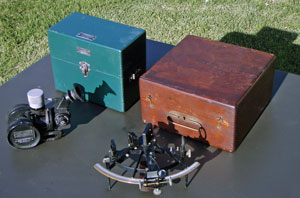 |
| Left, bubble octant and box; right, mariner’s sextant and box. |
Gatty’s opinion is understandable. The box found with the bones was of a type used for mariner’s sextants but aerial navigators used a different instrument. Taking celestial observations from an aircraft requires a way to assure that the instrument is being held level with the earth’s horizon. Specialized aeronautical “bubble octants” accomplished this with an air bubble that operated on the same principle as a carpenter’s level. Boxes for bubble octants were very different in size and shape than nautical sextant boxes.
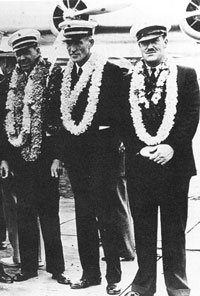 |
| L to R, Pan American Captain Ed Musick, Navigation Officer Fred Noonan, Engineering Officer Vic Wright, Honolulu, April 17, 1935 after California/Hawaii survey flight. |
Gatty may have been less dismissive had he been aware of a letter Earhart’s navigator, Fred Noonan, wrote to his mentor Lieut. Comm. P.V.H. Weems on May 11, 1935 in which he described the equipment and techniques he used in surveying trans-pacific routes for Pan American Airways. Buried amid discussions of chronometers and protractors is the statement “Two sextants were carried – a Pioneer bubble octant and a mariner’s sextant. The former was used for all sights; the latter carried as a ‘preventer.’”
Martin M-130 “China Clipper.” Navigation room, Martin M-130; Brandis sextant box inset. |
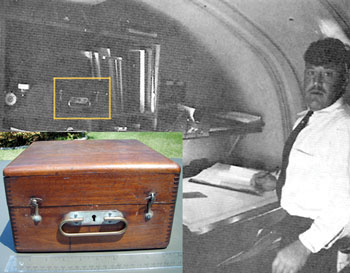 |
Carrying a mariner’s sextant as a back up to the bubble octant would make little sense unless the sextant had been modified with a bubble for aeronautical use, and there is some evidence that it was. A photograph of the navigator’s station aboard a Pan American Martin M-130 flying boat shows a bubble octant on a shelf beside a box for a mariner’s sextant. The Pan Am crew member in the photo is Flight Engineer Victor Wright. Wright flew all of the early trans-Pacific surveys with Noonan. The sextant box on the shelf in the photo can be reasonably assumed to have belonged to Fred. It could well be the same box that was later found on Gardner Island. A rash assumption? There’s more to the story.
 he distinctive hardware on the front of the box shows
it to be a Navy Surveying Sextant made by F. E. Brandis and Sons of Brooklyn,
NY. Brandis was one of several manufacturers who produced sextants for the
U.S. Navy during and immediately following WWI. In the spring of 1919 the
Navy’s Bureau of Aeronautics was preparing to attempt the first aerial crossing
of the North Atlantic with three giant Navy Curtiss (NC) flying boats. The
problem of celestial navigation during the long flight was addressed by another
student of P.V.H. Weems, a young Lieutenant by the name of Richard E. Byrd.
Byrd successfully modified several standard Brandis sextants with a bubble
device.*
he distinctive hardware on the front of the box shows
it to be a Navy Surveying Sextant made by F. E. Brandis and Sons of Brooklyn,
NY. Brandis was one of several manufacturers who produced sextants for the
U.S. Navy during and immediately following WWI. In the spring of 1919 the
Navy’s Bureau of Aeronautics was preparing to attempt the first aerial crossing
of the North Atlantic with three giant Navy Curtiss (NC) flying boats. The
problem of celestial navigation during the long flight was addressed by another
student of P.V.H. Weems, a young Lieutenant by the name of Richard E. Byrd.
Byrd successfully modified several standard Brandis sextants with a bubble
device.*
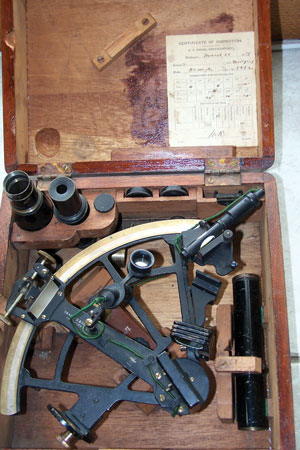 |
| “Byrd” sextant. Brandis Navy Surveying Sextant with bubble modification for aeronautical use. |
Byrd patented his modification and, in 1921, by then Lt. Comm. Byrd negotiated a royalties contract with Brandis for factory-produced Byrd Sextants. The following year, controlling interest in Brandis was purchased by the Pioneer Instrument Company which, in 1928, became a division of Bendix Aviation Corp. Production of Brandis sextants ceased in 1932 by which time Pioneer had developed the aeronautical bubble octant Noonan referred to in his letter to Weems. Obsolete Brandis instruments were sold as surplus to retailers like Negus Instruments of New York. It is, therefore, hardly surprising that Noonan’s back-up “preventer” in the mid-1930s would be a Brandis, and it is the Brandis brand that points toward the box found by Gallagher.
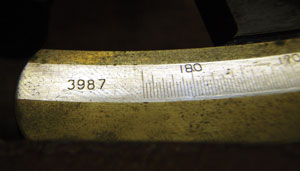 |
Maker’s number on sextant arc. |
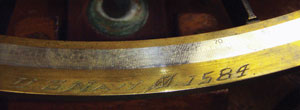 |
Naval Observatory number on sextant arc. |
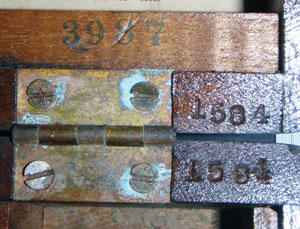 |
Brandis maker’s number (black ink) and Naval Observatory number (stamped into wood) on sextant box. |
Each Brandis Navy Surveying Sextant carried a chronological “maker’s number” etched in tiny numbers on the arc of the instrument and also stenciled on the inside of the box. As sextants entered the Navy inventory they were checked for accuracy by the Naval Observatory in Washington, DC where they received an N.O. number hand-etched in large numbers on the arc and, in some cases, also stamped into the wood of the box. So Navy-surplus Brandis sextants had two numbers – a maker’s number and a Naval Observatory number. More significantly, Brandis sextant boxes were marked with the stenciled maker’s number and, at least in some cases, a stamped-in N.O. number.
Gallagher: “Sextant box has two numbers on it 3500 (stenciled) and 1542 – sextant being old fashioned and probably painted over with black enamel. …”
Brandis sextants were usually painted with black enamel. But what of the numbers? Does 3500 make sense as a Brandis maker’s number and could 1542 be a Naval Observatory number? TIGHAR researchers have tracked down records for eleven Brandis Navy Surveying Sextants and donated the funds for TIGHAR to acquire three examples.
The instruments and boxes we’ve documented are listed in Table 1. Note that the N.O. numbers, although undoubtedly chronological by date of assignment, are not necessarily sequential with the maker’s numbers.
|
||||||||||||||||||||||||
|
||||||||||||||||||||||||||
Obviously, they do. Let’s try another test.
There are hand-written numbers on the bottom of sextant box known to have been owned by Noonan and now in the collection of the National Museum of Naval Aviation. The box is not a Brandis box, the sextant in it is not a Brandis, and the numbers on the instrument have no relation to numbers on the box, but the box has been modified with cut-outs that are not necessary for the sextant it now contains. Do the numbers fit in the Brandis sequence? Did this box once hold another Brandis sextant? Table 3 may tell us.
|
|||||||||||||||||||||||||||||

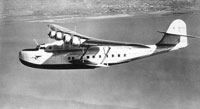
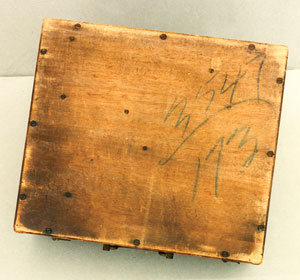 That’s two for two. Now let’s test the “null hypothesis” that any pair of
random numbers would fit the documented sequence just as well as the numbers
reported by Gallagher and the numbers on the box known to be owned by Noonan.
Get out that piece of paper and see how well your numbers fit. Let me guess.
Not so good. Right?
That’s two for two. Now let’s test the “null hypothesis” that any pair of
random numbers would fit the documented sequence just as well as the numbers
reported by Gallagher and the numbers on the box known to be owned by Noonan.
Get out that piece of paper and see how well your numbers fit. Let me guess.
Not so good. Right? o what do we have
here? A smoking gun? Not quite. We’re
trying but, so far, we’ve been unable to find documentation to prove that
Brandis 3500 was assigned N.O. number 1542 or that it was owned by Fred Noonan.
Research continues. What we can say for certain at this point is that Fred
Noonan appears to have owned a sextant box that fits Gallagher’s description
of the box found with the castaway’s bones. To paraphrase Merle Haggard, “It’s
not a smoking gun, but it’s not bad.”
o what do we have
here? A smoking gun? Not quite. We’re
trying but, so far, we’ve been unable to find documentation to prove that
Brandis 3500 was assigned N.O. number 1542 or that it was owned by Fred Noonan.
Research continues. What we can say for certain at this point is that Fred
Noonan appears to have owned a sextant box that fits Gallagher’s description
of the box found with the castaway’s bones. To paraphrase Merle Haggard, “It’s
not a smoking gun, but it’s not bad.”